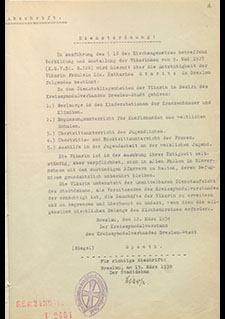Vicar in Breslau
After completing her undergraduate degree and doctorate in Marburg, Katharina Staritz returned to Breslau in order to begin a vicarage in the Old Prussian Church Province of Silesia. A church law of 1927 regulated the training and hiring of female theologians in the Evangelical Church of the Old Prussian Union.
Although they had to fulfill the same academic and practical requirements as pastors, rather than being ordained like their male colleagues, they were merely consecrated afterward and employed with greatly reduced rights and significantly lower salaries than female parish officials. They were even denied the title of “pastor”. Instead, they permanently received the official title of “vicar”, which in and of itself signaled their hierarchical position beneath a pastor.
Katharina Staritz completed her vicarage at a variety of assigned locations and in differing functions with the Protestant Women’s Aid Society in Silesia, at the Church of the Eleven Thousand Virgins in Breslau, the deaconess motherhouses in Frankenstein and Grünberg and the church in Schweidnitz.
She completed her vicarage when she passed her Second Theological Exam on March 9, 1932 and was hired as a city vicar by the city of Breslau’s district synod, effective July 1, 1933. She worked intercongregationally there in hospital chaplaincy for children and taught confirmation class and Protestant religion class for women. She was additionally responsible for children’s services and Women’s Aid Society events, house calls and a variety of pastoral work.
She was not made a civil servant until 1938 when she reached the legally prescribed age for women of thirty-five. Her consecration, which she herself called “ordination” just like other female theologians, was held on November 6, 1938 in the Church of St. Mary Magdalene in Breslau.
In the clashes between the Confessing Church and German Christians in the Kirchenkampf, Katharina Staritz stood by the Confessing Church, became a member of the Pastors’ Emergency League and held to the Theological Declaration of Barmen.
After the Confessing Church’s split into a “moderate” and a “radical” wing in 1936, which even prompted the formation of two separate confessional synods in Silesia, she initially harbored sympathies for the “moderate” wing of the Confessing Church. Later, she found the “radical” wing more convincing.
Source / title
- © Ev. Zentralarchiv in Berlin, Best. 7 Nr. 14311

